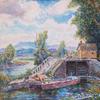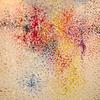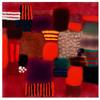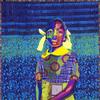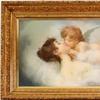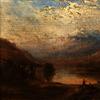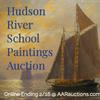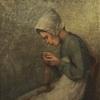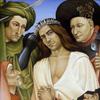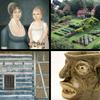Before Instagram, There Were Envy-Worthy 'Travels on Paper' as Shown in New Exhibition at The Clark
- WILLIAMSTOWN, Massachusetts
- /
- October 01, 2019
From John La Farge's alluring South Seas watercolors to Roger Fenton's 'Orientalist' photographs staged in his London studio, artists fueled travel trends and wanderlust with works on paper long before social media gave rise to our armchair escapes and dream trip influencers.
For centuries, travelers have made visual records of their journeys and eagerly shared their views of distant lands and unfamiliar locations. In addition to their souvenir value for the person who makes them, such images often fuel an appetite for travel among the people who see them—as advertisers and tourist bureaus well know. Travels on Paper, on view at the Clark Art Institute November 16, 2019 through February 9, 2020, explores travel pictures—drawings, prints, and photographs—that capture the experience of being a traveler and image maker. With works drawn primarily from the nineteenth century, the exhibition provides a look at the power and influence of images long before the Instagram age. The exhibition includes forty-three works by artists Camille Corot (French, 1796–1875), Robert Macpherson (Scottish, c. 1815–1872), Alexandre-Gabriel Decamps (French, 1803–1860), John La Farge (American, 1835–1910), Thomas Moran (American, 1837–1926), Félix Teynard (French, 1817–1892), and many others.
“Exotic locales and faraway lands have always inspired curiosity, but the kinds of works in this exhibition truly inspired wanderlust,” said Olivier Meslay, Hardymon Director of the Clark Art Institute. “Travels on Paper provides our visitors with the opportunity to be armchair travelers … both to these destinations and to the past. We think they will be fascinated by this look back at the early forms of travel imagery and inspired by the beauty of these works.”
The speed and relative ease of travel is taken for granted in contemporary society. In the nineteenth century, however, the opportunity to visit renowned sites and experience faraway locales was limited to a privileged few, and the journey could often be perilous and arduous. Similarly, capturing images of one’s travels was a slower and more difficult process than what today’s smartphone camera users know, particularly in the case of early photography, which involved excruciatingly long exposure times and required photographers to haul heavy loads of equipment and chemicals.
“Today’s travelers can book a trip with the click of a mouse or a tap on a screen. They arrive at distant locations in less than a day, and their travel images, posted on social media, reach people around the world within seconds,” said Manton Curator of Prints, Drawings, and Photographs Anne Leonard. “It is my hope that visitors to Travels on Paper will be transported imaginatively back to a slower era, when visual records of travel were more difficult to create and circulate. The magnificent images in this show were also less ephemeral, and they are guaranteed to inspire daydreams of faraway lands.”
Through drawing, the traveling artist captured private reminiscences and fleeting moments that might be ends in themselves or could later serve as inspiration for a more finished work. Jean-Honoré Fragonard’s (French, 1732–1806) intimate red chalk drawing The Hermit’s Court in the Colosseum (1758) depicts the already ruined state of the famous ancient Roman landmark that was captured by innumerable tourists and artists throughout its history.
In contrast to Fragonard’s relatively comfortable conditions in residence at the French Academy in Rome, adventurous nineteenth-century artists who journeyed to the Sahara faced much more difficult travel. Eugène Fromentin (French, 1820–1876), who had to be accompanied by a French military escort because of unstable political conditions in North Africa, documented the severity of the desert in his 1853 drawings El Aouila and B’etoum.
In 1890 John La Farge set off for a South Seas voyage with the historian and writer Henry Adams. He would return from the tour with nearly two hundred watercolor sketches, often accompanied by jotted descriptions to serve as reference material for later compositions. Travels on Paper includes three images from La Farge’s year-long wanderings: Hut in Moonlight, Iva, Savaii, October 1890 and Siva with Siakumu Making Kava in Tofae’s House (c. 1893), which depict Samoa, and Behind the House, Nuuanu Valley, Honolulu, Rainbow on Mountains (1890) painted in Hawai‘i.
Many nineteenth-century artists considered etching to be as spontaneous and expressive as drawing and utilized this printmaking medium to capture the places they visited. Printed imagery allowed multiple copies of a single image to circulate, resulting in scenes of foreign countries, majestic monuments, and picturesque views reaching a wider public. Jean-Baptiste-Camille Corot’s Souvenir d’Italie illustrates how a single image can serve both as a sensitive personal remembrance and as a commodity in the print marketplace. The original etching, from 1863, was printed on bright paper without any inscriptions and was likely intended for the artist’s safekeeping or a gift for a close friend. The second example in the exhibition dates from 1866 and, as indicated by the inclusion of the name and address of the printer (Auguste Delâtre) and publishers (Alfred Cadart and Félix Chevalier), was editioned for sale.
Perhaps more than other nineteenth-century image-making methods, photography (invented in 1839) posed challenges that are hardly fathomable today. Intrepid pioneers of the new medium carried heavy, equipment and volatile chemicals over sometimes rugged terrain. These photographers sought, in some cases, to document “slices of life” particular to their locale, while others focused on a more standard roster of monuments and natural features catering to tourists’ tastes.
In 1858 Roger Fenton (English, 1819–1869) published his Orientalist Suite comprising fifty photographs, including Orientalist Study, purportedly depicting a range of ethnicities. Although Fenton did travel widely during his career, notably as a war photographer, the images for this series were created in his London studio using his friends, manservant, and a professional artist’s model as subjects—a jarring discrepancy noted by critics of the time. The assortment of costumes, furniture, and accessories collected from across the Near East and used in the images may have been borrowed, brought up to the studio from Fenton’s home, or purchased for the occasion. The images, although executed to technical perfection, are pastiches rather than ethnographic depictions. In this, as in so many examples, travel images that purported to be objective documentary records of a foreign culture were deeply conditioned by the image makers’ own expectations, biases, and frames of reference.
Travels on Paper is organized by Anne Leonard, Manton Curator of Prints, Drawings, and Photographs, with assistance from curatorial intern Andrew Kensett, Williams Graduate Program in the History of Art, class of 2020.



